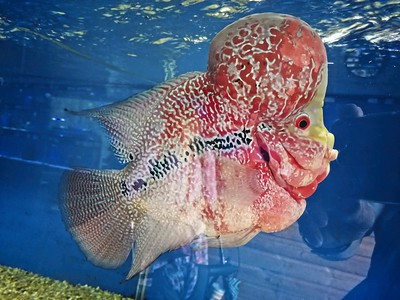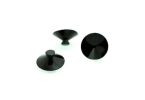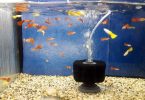Table of Contents
Flowerhorn Cichlids
The world of aquariums is enormous and brings balance to the ecosystem. Are you thinking of how to begin an aquarium farm whether it be for subsistence reasons, or for commercial reasons, or even for the fun of having it, just like people have animals kept as pets in their homes.
Flowerhorn Cichlids are decorative or ornamental fishes best and usually identified with their glowing colours, and oblong shaped hump on their heads; a very distinctive feature that could be the only seeming thing not very beautiful about the bright coloured fish.
However, they are named as a result of their very bright and vivid colours, as well as the distinct shape of heads, this shape is usually called a “nuchal” hump or kok.
More so, they are artificial hybrids that do not exist in nature. They are hybrids that exist as bait or food for other fishes, Cichlids like tilapia are mostly food fishes, while flower Cichlids like Cichla are highly valued hunting fishes or for game reserves.
Flowerhorn Cichlids however, are usually well known for their adaptive features with which they have evolved rapidly into different closely knitted yet structurally diverse species that inhabit large lakes.
We will be sharing in this article a care guide for Flowerhorn Cichlids so that you can give your fish the exact care they deserve ranging from their Tank mates to their diets, and other tips. Read through the end and enjoy the ride.
What do the flowerhorn Cichlids look like?
Already, we have tried to describe the Flowerhorn Cichlids in the preceding section which is the introductory section. Here we will briefly state a few more things about the Flowerhorn Cichlids.
First it is important to note that Flowerhorn is just one species of Cichlid. However, like other fishes, Flowerhorn Cichlids have scales, possess eyes for sight, and have tails and fins, and triangular mouths.
They are rarely big in size, and can camouflage to fit in an environment as a result of their ever changing bright colours.
Types of Flowerhorn Cichlids
Of course it is common knowledge that every living thing has different species, family, class, and generally types.
In this section, we will be looking at the different types of flowerhorn Cichlids, or varieties as you may prefer.
Flowerhorn Cichlid hybrid stock were initially called luohans, which is a Chinese word and the buhdist idea of arhat
Here’s a carefully compiled list of the four major types of Flowerhorn Cichlids:
- Zhen Zhu Flowerhorn
- Golden Monkey Flowerhorn
- Kamfa Flowerhorn
- Golden base group Flowerhorn
1. Zhen Zhu Flowerhorn:
The Zhen Zhu Flowerhorn is also known as the ‘Pearl Flowerhorn’ and is famous for its pearling, which is its strongest characteristic of this type of Flowerhorn Cichlid.
Interestingly, this variety of Flowerhorn Cichlid is said to have been discovered or come to existence after the flowerhorn Cichlids called “kamfa”. And it has very amazing features which include the following: a pronounced head, a round but weak tail, a large buccal cavity, and red bulgy eyes.
Being a very pearling flowerhorn and a very fertile one, rearers often cross breed the Zhen Zhu flowerhorn with the other types of flowerhorn so as to reproduce a more appealing flower line or pearling for the next filial generation.
2. Golden Monkey Flowerhorn:
The first breeders of the Golden Monkey Flowerhorn were Lam Soon and Lam Seah.
It was bred at Malaysia, Bercham, and Ipoh, as an original Luohan habitat fish, unlike Kamfa and Zhen Zhu that are usually mixed types of Flowerhorn.
The Golden Monkey flowerhorn is also known as Good fortune, or Kamalau. It is very beautiful and very expensive; it is probably the most expensive flowerhorn Cichlid.
Wikipedia records that some of the expensive golden monkey were sold at about sixty thousand USD in two thousand and nine (2009), during an exhibition in Malaysia where Flowerhorn Cichlids were first bred. It is important to note that most golden monkey flowerhorn Cichlids have smaller humps.
3. Kamfa Flowerhorn:
The Kamfa flowerhorn like other flower horns originated from the Luohan habitat, and can be bred with a Flowerhorn other than its type.
Kamfa Flowerhorn cichlids usually have white and yellow eyes, some of them have red eyes, but they all have eyes that are small or what humans recognize as melancholic eyes (their eyes sunken deep), a nuchal hump that looks like a head bump that is water coloured, smaller lips than that of the Zhen Zhu flowerhorn, a larger but square body, and a flat fan tail.
There are other types of flowerhorn cichlids that belong to the Kamfa family and they are as follows: King Kamfa, Kamfamalau, and Thaisilk.
-
King Kamfa
The species of king kamfa in the family of the flowerhorn cichlids is identified by its big kok, that is the nuchal humps common to all flowerhorn cichlids, and their obvious glaring patterning.
The King Kamfa usually has yellow or white sunken eyes, although they could have red eyes but that is usually very rare.
However, the following are striking features of the King Kamfa flowerhorn cichlid of the Kamfa family: A dual row of flower on its lateral line that is usually black, and a heavily thick white pearling.
Being generated first from Thailand, this type of flowerhorn Cichlid, has also been a current rebirth within the country in Vietnam.
As expected, it has the body of a Kamfa, a body longer than that of other kamfa species, and tail fan that is flat. And is quite expensive.
-
Kamfamalau
This is a crossbreed of the malau female flowerhorn and then the Kamfa male flowerhorn. It has the appearance of a Kamfa, The Kamfamalau has fins, a tail, and a sunken eyes. Like the
Zhen Zhu, the Kamfamalau’s main feature is its appealing pearling. The fin typically is a frosted, pearl, an appearance that is seldom seen with other types of cichlids.
Aesthetically, it’s pearl crosses through the nuchal head hump, which is also another significant difference in the different types of flowerhorn.
This type of flowerhorn cichlids clearly shows the best features of both the Kamfa flowerhorn cichlids and the Malau cichlids put together.
-
Thai Silk
It is usually controversial to place the Thai Silk in the family of the Kamfa breed of flowerhorn cichlids because of the titanium which is a thai silk, a fresh type of the Kamfa breed of flowerhorn cichlids because of its type of cross breeding which is not very clear as it involved series of cross breeding.
The Thai Silk flowerhorn cichlids of the Kamfa family usually takes one of the following colours; gold, white or metallic blue.
A variety of the Thai silk Kamfa breed flowerhorn cichlids has been bred. This new breed of the thai silk has a square shaped body like that of the kamfa, with a pair of eyes that could be white, or yellow, or red.
4. Golden Base Group Flowerhorn:
Golden base group flowerhorn as the name implies is multiple different flowerhorn Cichlids, which includes, Faders and Golden Trimac.
The colour of the golden base group flowerhorn is a very distinctive feature that distinguishes golden base group from other flowerhorn cichlids.
For instance, faders go by the nomenclature faders because in the early stages of life cycle, they usually lose their vibrant colours, and turn black completely.
But they continue to fade, and the process of fading continues, the black colour slow gives way for the bright colour that covers the scale. It is usually yellow or red as the case may be.
Another type of the golden base group is the Red Texas flowerhorn cichlids. The colour is red just as the name implies.
This flowerhorn Cichlid came into existence by the mating or rather by breeding a King Kong parrot flowerhorn cichlids or a Mommon flowerhorn cichlids with a green Texas flowerhorn Cichlids.
Then, the young one is crossbred again with the Red Texas Flowerhorn cichlids to give the Cichlid a permanent red color just as the name implies.
Like stated earlier, colour is a very distinctive feature of the gold based group, so for the Red Texas, the colour red is its very distinctive red colour. Red Texas Flowerhorn cichlids vary in colours.
Here are the colours in grades:
- The lowest grade of Red Texas flowerhorn Cichlids are called unfaded.
- The next to the lowest grade of Red Texas
- About the higher categories, most of the Red Texas fall under this category, and the colour is usually orange.
- Next to this is the slight pinkish colour. A bit pink and red, but not quite full red, it’s called the Coral colour.
- Now the most alluring colour of the Red Texas flowerhorn Cichlids is the red colour. It takes after the name of the Red Texas flowerhorn Cichlid.
- Another distinctive feature of the Red Texas Flowerhorn Cichlids is that it is usually pearling in nature; some of them. Red Texas Flowerhorn belongs to the category of the Gold base group gold trimac.
Flowerhorn Cichlids Health and Common Diseases
However, as a living thing, flowerhorn cichlids from being involved in the daily activities that affect its habitat could have a toll on its health which is why we will in this section share some common diseases that could disrupt the good health enjoyed by the flowerhorn cichlids.
If the flowerhorn cichlids’ tank is dirty, or if it is fed inadequate diet, or it has a bad tank mate, here is the kind of ailment that could befall the flowerhorn cichlids regardless of its type or variety.
- Hexamitiasis disease
- White spot disease
1. Hexamitiasis Disease
Hexamitiasis is a disease that results in a hole in the head of flowerhorn cichlids. The disease is caused by a water parasite called hexamita that is usually found in the gastrointestinal tract of a fish of which the flowerhorn cichlids are not exempted.
This parasite is caused by malnutrition, overcrowding of the tank, careless shipping, and dirty water or poor water quality which enables the massive reproduction of the flagellated protozoan responsible for the reproduction of the parasite hexamita.
More so, the hexamita has three different species that inflict ailments on fishes and they are as follows: Hexamita intestinals, Hexamita salmonis, and Hexamita truttae.
When a flowerhorn cichlid or a fish is affected by the parasite, the flowerhorn Cichlid gradually begins to develop tiny lesions around its flanks and on its head.
Like most parasites, the hexamitiasis disease can be very deadly especially if it is not detected and properly treated early enough.
If the hole in the head is treated as soon as it is detected, chances are that the infected flowerhorn cichlid will get cured and survive the ailment.
Just like it is safe for humans to seek medical care and attention, it is also safe for veterinary doctors to be given the opportunity to give infected flowerhorn Cichlid the medical care they need.
However, in cases when it is difficult to take the fish to a veterinary doctor, one can attempt to treat the flowerhorn cichlids of hexamitiasis by purchasing and using an over-the-counter medication that can be gotten from any good local fish store.
2. White Spot Disease
White spot disease is another parasitic disease of fish which the flowerhorn cichlids hybrids still get affected with. The white spot disease, also known as “Ich”, has been proven to be caused by
Ichthyophthirius multifiliis. The parasite after moving through the bottom of the pond infects the flowerhorn cichlids.
Then like is common with parasites, Ichthyophthirius multifiliis attaches itself to the body of the flowerhorn cichlids, gradually floating under the skin or scales as it is called, where it parasitically feeds on the cells and on the body fluids of the flowerhorn cichlids.
Overtime, as the parasite life cycle progresses, Ichthyophthirius multifiliis moves out of the body of the flowerhorn cichlids and attaches itself to the pond or tank where the flowerhorn Cichlid lives.
The parasite repeatedly splits itself into one thousand more cells, and rapidly multiplies. The cells mature, then hatch and a new cycle begins the process again.
The parasite leads to bacterial and fungal diseases which deal tremendously with the flowerhorn cichlids. However, it is easily spotted because just as the name implies, it leaves white spots and patches on the body of the flowerhorn cichlids.
When infected, the fishes rub themselves against the tank or against each other trying to find some form of comfort.
Sadly, white spots disease is contagious and affects all types of fishes and aquariums, it also affects human beings.
Should your fishes be affected by the white spot disease, kindly visit any local fish store around you because delay can be very deadly?
Flowerhorn Cichlids Care Guide
These preceding sections have laid a foundation for us up to this section which is the crux of this article. In this particular section, we will be sharing with you dear practical and do it yourself
(DIY) care guides that could help you take absolute care of your flowerhorn Cichlids.
This will include best breeding techniques, diseases prevention, tank mates, behavior and temperament, and a whole other technique required for a proper flowerhorn cichlids care guide.
We will begin with disease prevention.
Disease prevention as a care guide tip:
One care guide that must not be left out is the disease prevention tip. Prevention is always better than cure.
To achieve this, clean the Tank thoroughly, maintain a good filtration system, and change the water weekly also, wash any new flowerhorn before introducing it to the Tank as a tank mate.
You can begin by quarantining the tank for at least two weeks to be certain that it’s healthy.
More so, Flowerhorn feeds on a meaty diet that is best supplemented with cichlid pellets. So daily healthy feeding will keep the fish healthy.
Flowerhorn Tank mates
The flowerhorn, though pearling and alluring, has a temperament that directly opposes its harmless appearance.
However, because of the aggressive nature of the fish, it is best to keep them singly, otherwise the pair or mates must be put in bigger tanks, spacious enough to accommodate them especially when their aggression comes knocking. You could also design obstacles that could be used to mark their territories in the Tank.
This is also applicable to breeding pairs, set up a spawning tank to help the female hide when the male becomes aggressive.
Conclusion
Flowerhorn cichlids are amazing species that require great expertise so that the fishes do not end up dying. More so these decorative fishes could be used as a decorative piece in your home, you just need to be able to put it in a well-kept Tank.







